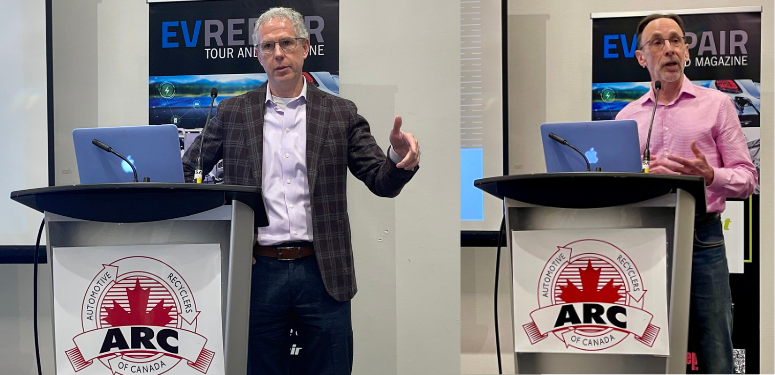Toronto, Ontario — The Automotive Recyclers of Canada hosted more than 80 members of the Canadian automotive aftermarket for an in-depth discussion on electric vehicles and how electrification will impact the auto recycling, collision repair and other automotive industries.
The event was separated into four parts: Steve Fletcher, managing director of the ARC, welcomed attendees before environmental consultant Maria Kelleher; battery whiz Jeff Haltrecht of Call2Recycle and Ryan Mandell of Mitchell International each detailed a respective part of the electrification process and its effects.
“No one is really looking into the end-of-life side of electrification,” explained Fletcher in his welcome address. “Yet 40 percent of ARC members are processing end-of-life EVs, according to a 2022 survey.”
A general overview: How many batteries and what can we do with them?
By 2035, the Canadian government wants 100 percent of new vehicle sales to be electric, which translates to approximately two million units sold in all.
To get there, the federal government aims for 20 percent of new vehicle sales to be electric by 2026—which equals approximately 395,000 units sold—and for EVs to comprise at least 60 percent of new vehicles come 2030 (with about 1.2 million EVs sold, total).
According to current data from the International Energy Agency (IEA), there will be a significant spike in the number of EOL EV batteries between 2030 and 2040. Contrary to public perception, electric vehicle batteries are outliving the EVs they’re housed in.
“When an EV battery is no good for the vehicle itself, it still holds between 70 percent and 80 percent of that charge,” explained Kelleher. “It’s no good to run a vehicle, but it works for energy storage and other applications.”
EV battery life can be extended by up to ten years via reuse, said Kelleher; up to 15 years, according to a Toyota study, she added.
There are a few different ways to repurpose a battery, she explained. The first, and often consider the most ideal option, is to refurbish and reuse the battery secondhand in an EV. Alternatively, EV battery packs can either be combined with others to create energy storage systems or backup power sources; or separated into smaller units for reuse in smaller applications—like in wheelchairs or golf carts.
If the IEA’s predictions pan out by 2030, battery recycling efforts will only supply 12 percent of demand.
“Recycling won’t solve the supply problem, but it will help.”
“Significant dismantling is required [to reach the valuable materials],” which, to recyclers, would be cobalt, nickel and copper."
— Maria Kelleher, Kelleher Environmental
Kelleher elaborated that EV batteries contain a multitude of different components, including copper wiring, circuit boards, a variety of chemistries (i.e. nickel cobalt aluminum; nickel manganese cobalt; lithium iron phosphate, etc.) and come in a variety of different power sizes—two factors that make them hard to recycle.
“Significant dismantling is required [to reach the valuable materials],” which, to recyclers, would be cobalt, nickel and copper, said Kelleher.
The path most travelled: What do we do with used EV batteries?
According to Haltrecht, one of five things can be done to an EOL EV battery: repair or remanufacture the unit; resell the battery as-is; repurpose the battery or recycle it all together.
“There are five different pathways the battery can hop to, depending on a number of factors: the health or geographic location of the battery; which damage stream activity is closest [geographically] to the battery; who has a contract on that battery and so on,” he explained.
Currently, the majority of EOL EV batteries are handled by dealers, said Haltrecht. He explained that dealerships may have unique access to shipping containers through the connection to OEMs, whereas recyclers may have to find a logistics partner for their own shipping container access.
“And it’s still too early to tell how long these shipping containers will last,” he added.
Haltrecht acknowledged that there are plenty of other questions about handling EV batteries as a repairer or recycler.
“Sharing what works and what doesn’t work is probably of the single best things we can do today.”
Anyone working on or planning to handle EVs or their components in their facility should have a thermal sensor/thermal imaging gun, a four-gas meter (that detects different gases given off by EV batteries), a fire blanket and heat-sensitive gloves on-site, Haltrecht told the audience.
“That’s the absolute minimum for safety equipment you should have on-site,” he said.
In terms of developments on detecting the health of and potential pathways for EV batteries, Haltrecht said he “can see where this is going.”
“We’ll have a highly robust algorithm app on our phones, with a special cable that connects to the vehicle [to read battery diagnostics]. At certain sites, like a dismantler’s, you’ll be able to get a [battery health] reading. We’re just not quite there yet.”
The most common reasons for battery degradation are typically factors like temperature, altitude, number of charge cycles and the type of load; fast chargers will degrade a battery faster than a normal charger, added Haltrecht.
“[The lack of safety standards] is the weakest link—and the weakest link can bring down an industry.”
— Jeff Haltrecht, Call2Recycle
He ended his portion on the mic with a number of policy suggestions for lawmakers.
“We are a North American industry—cars and parts travel across the borders to be built. The batteries will also move around. We need one policy to standardize everything.
“If we don’t, car prices will [be] drive[n] up due to batteries being stranded, simply because it’s too cumbersome to deal with them.”
Haltrecht also said that any policies around EV batteries should support the entire useful life of the battery; not just the time it’s working in a vehicle.
“Don’t force an early retirement on a battery when you’re talking about policy.”
Current regulations should be reviewed and amended, said Haltrecht, specifically to allow EV batteries destined for recycling to cross the border without permits, just as those being remanufactured are permitted, and shipping container requirements should be aligned with U.S. DOT.
Finally, standards and/or safety requirements are EV battery recycling should be developed as soon as possible.
“[The lack of safety standards] is the weakest link—and the weakest link can bring down an industry.”
Time to strategize: EV repair complexity and cost
New vehicle sales fell eight percent in 2022, but new sales of EVs grew by a whopping 65 percent in the same period.
According to statistics from Mitchell International, 2.5 percent of repairable claims processed through the Mitchell platform in 2022 were EVs. The data collected on these claims demonstrated the increased complexity of EV repairs, Mandell told audiences at the EV Roundtable. In fact, the average EV repair takes an extra 2.5 days of cycle time and six additional labour hours.
This results in a “pretty significant” difference in the cost of repair between an ICE vehicle and an EV.
“If EV adoption continues to maintain its growth pace, the average repair could cost about $8,000 by 2035. Today, it’s about $4,600.”
— Ryan Mandell, Mitchell International
“If EV adoption continues to maintain its growth pace, the average repair could cost about $8,000 by 2035. Today, it’s about $4,600.”
There are nearly twice as many semiconductors in an EV, compared to an ICE vehicle, said Mandell. ICE vehicles have about 1,000 semiconductors, where EVs contain about 2,000.
Mitchell’s scans also showed increased complexity with EV repairs—a 2018 ICE vehicle had 31 codes, while a 2018 EV threw 40 codes.
Lightweight substrates only add to the complexity.
“You simply just don’t have the same opportunity to repair aluminum, carbon fibre or composites that you do with steel. Steel has a memory. It likes to go back to its original shape. Those other materials do not.
“The rate of repair [with lightweight materials] drops about ten percent,” added Mandell. “That will give recyclers a lot of opportunity.”



























